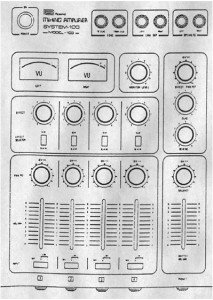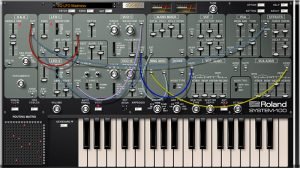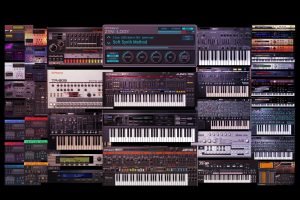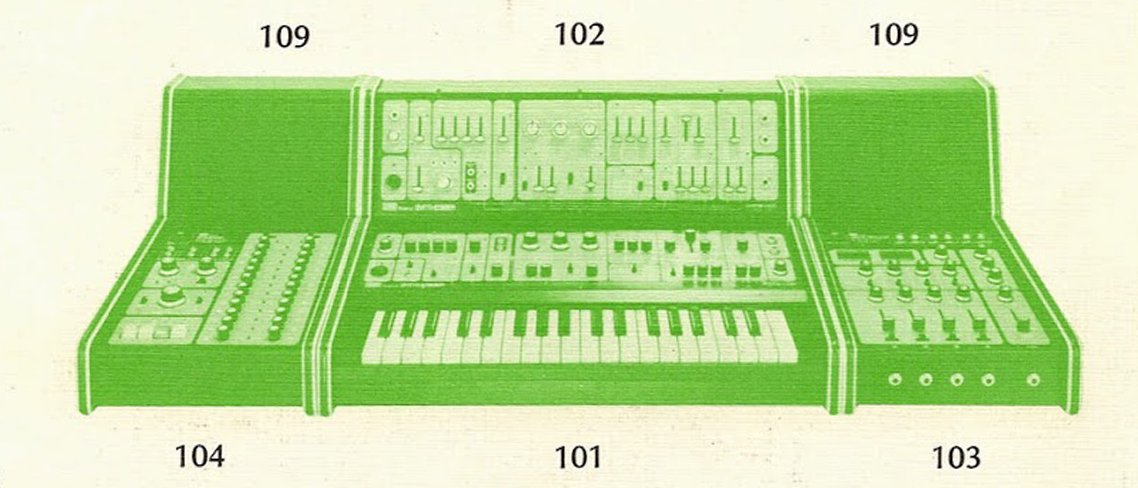![]()
The Roland Icon Series is a collection of articles looking back at the most popular and recognised Roland instruments. In over four decades, Roland has designed many world-first instruments like the first touch-sensitive keyboard and first guitar synthesizer.
Contributed by Kerry Panara for the Roland Resource Centre
Previous articles in the Roland Icon Series looked back on the classic Roland SH-101, Roland MRS-2 ProMars and SH-2 Monophonic Synthesizer. This article looks at the classic Roland SYSTEM-100 Synthesizer.
THE YEAR 1976
As a 14 year old growing up in the 70’s, the charts were littered with a vast array of diverse “pop” songs – some iconic, and some best left in the one-hit wonders category. However, some of my early musical influences started to develop with the infectious melodic, layered arrangements of ABBA, through to the magic of Queen, and of course the early developments of synth pop. Little did I know there would be a cultural shift in the 80’s that would ultimately evolve the synthesiser into a worldwide phenomenon of progressive rock, synth pop, new wave and electronic art rock.
Enter the Roland monophonic synthesizer. Roland had officially established itself as a company in 1972 and we saw Japan’s first ever synth the Roland SH1000 appear in 1973. This was the start of something special as its development and technology set the course of synth history as we know it today. Little did we know back then, that these instruments would have a profound effect in the decades of music that have preceded since the 70’s.
THE ERA OF ANALOGUE
In 1976 we saw the release of the Roland SYSTEM-100 – comprising of 5 semi-modular products :
• The 101 Synthesizer Keyboard
• The 102 Expander Module
• The 103 Four-Channel Mixer
• The 104 12×2 Step Analogue Sequencer
• The 109 Speakers
These five modular components, when fully combined for the full SYSTEM-100, provided a powerful instrument as it combined the keyboard and modular synthesizer world. The 101 Synthesizer is the heart of the system from which you could add on any of the modules of your choice. The different combinations allowed these components to provide complex & variable creating of sounds through its cable patching system.
Lets take a look a brief look at each of the components and some of their technical specs :
101 SYNTHESIZER
The 101 synthesiser section is a fully self-contained analog mono-synth. It features a 37-note keyboard that featured lots of sliders & dials to encourage the end user to “tweak” the sound. By controlling the VCO, LFO and VCF high-pass/low-pass filters, one could create incredibly thick sub-harmonic bass lines, to rich sounding warbling filter resonating effects. In addition there were VCA with ADSR, Noise & Portamento / Glide effects controls, along with a A-440Hz tuning oscillator.
102 EXPANDER
The 102 Expander section was a keyboard-less version of the 101 and it was designed to stand upright behind the main 101 synthesizer. The Expander is identical to the 101 in many of its features however the Portamento/ Glide feature was replaced with a Sample and Hold feature for the LFO section. Other features such as the Noise Generator was replaced by a Ring Modulator and the A440Hz tuning oscillator replaced by a weak/ strong sync input and mix-in jack.
The Expander was designed to add more oscillators and synth effects ( adding the Sample & Hold & Ring Modulator ) as part of the System 100 concept. Once the 101 & 102 modules were combined, both oscillators could be synced. Although the modules would be internally patched, their sounds could be bypassed as well through external patching.
 103 MIXER
103 MIXER
The 103 Mixer section features 4 inputs with 4 sliders that would mix down to 2 outputs. The inputs contain selectable high and low impedance line level switches allowing you mix other passive instruments as well as synthesizer signals. There was also a headphone jack incorporated into this design, to cut off the sound from the 109 speaker set.
Other features included Panning, a Mono-Effect sends & return and a pretty cool in-built Spring Reverb. In addition, there were two old school style analogue VU meters that showed the average amplitude of the output signals. The 103 was unique in that it not only provided stereo monitoring outputs for its speakers but an additional Line-Out for Live or Recording Studio applications. The mixer was designed to sit on the right hand side of the System 100 setup and link into the 109 speaker system.
104 SEQUENCER
The 104 Sequencer is a 12×2 Step Sequencer that was used to drive or create sequenced step patterns. The 104 includes variable gate time, series or parallel modes, a stop, start, continue and step button transport system. Twenty-four vertical knobs take center-stage in the 104 Sequencer, each row of twelve having an individual voltage t control your oscillator pitch, filter cutoff, VCA amplitude etc. The End Step function allows you to control the number of steps in the pattern via Channel A or Channel B.
These two channels (A and B) allow for some interesting patterns to be generated. Series Mode sends Channel A then Channel B sequence out, controlled byt the End Step feature. However, more dynamic patterns can be created with a flick of a switch into Parallel Mode. Parallel Mode output two separate control voltages for each step in the sequence and can be triggered via Repeat Mdoe (as in most traditional sequencers) or One-Shot Mode for single melodic triggered phrases.
109 SPEAKERS
The 109 Speaker Set was last the add-on component designed to complete the System 100. These speakers were unpowered and rated at 3.5watts each at 8ohms. The speaker set allowed the SYSTEM-100 to be a complete synthesizer system for monitoring and performance.
The System 100 is an ultra-rare and much coveted Classic Analog synth and is still sought after to this day due to its filter, sequencer & complex patching capabilities. The next time you are listening to Kraftwerk, Depeche Mode, Human League, Erasure, Vangelis, Tears for Fears, Hans Zimmer and Tangerine Dream these are just a few of the iconic artists who have used the System 100 on their albums or movie scores.
![]()
https://www.rolandcloud.com/catalog/legendary/system-100
Now you can have the System-100 on your computer with Roland Cloud!

The New SYSTEM-100
With the new SYSTEM-100 Synthesizer VSTi, the sound of this legendary instrument is perfectly reproduced and brought to life with Analog Circuit Behaviour (ACB). ACB faithfully captures the sound and feel of our most revered classics, using original design specs, and a detailed, part-by-part analysis of each analogue circuit. While the sound and behaviour is reproduced with total accuracy, there are a number of modern additions that improve upon the original design.
The features of the original Model 101 Synthesizer and Model 102 Expander are combined into a single interface, allowing you to use both VCOs, both LFOs, S&H, Ring Mod and so on with no patching. Of course, the signal path can be altered, and parameters modulated by connecting cables between the patch points. A new 14×15 Routing Matrix makes for super-quick patching with all connections still visually reflected as patch cables on the SYSTEM-100’s control panel. You can toggle patching on/off as well as quickly see the entire signal flow with convenient buttons right above the Routing Matrix.
Like other PLUG-OUTs there are dual ADSR envelopes (VCF and VCA) and the advanced pattern generation of the Scatter equipped Arpeggiator. Six arpeggio types with six step settings combine with variable Scatter type and depth to create a seemingly infinite selection of patterns. A lush phaser with modulation inputs joins the superb reverb and delay, creating an effects section perfectly suited for synth sounds.
Features
The SYSTEM-100 PLUG-OUT Software Synthesizer is a modern reproduction of the now-legendary semi-modular monosynth from 1975. It integrates the features of the original Model 101 Synthesizer and Model 102 Expander units, resulting in an incredibly fat and uniquely versatile two oscillator monosynth with modular routing capabilities. Designed for Mac and PC hosts, the new SYSTEM-100 uses Analog Circuit Behaviour to faithfully recreate every detail of the warm, expansive sound of the original, with a level of authenticity that can only come from Roland.
- Perfect replica of SYSTEM-100 sound and behaviour
- ACB provides expansive, liquid tone of the original
- Model 101 Synthesizer and Model 102 Expander in a single instrument
- Sophisticated architecture with dual VCO, dual LFO, S&H, Ring Mod, Noise and more
- Versatile semi-modular patching capabilities
- Integrated Phaser with modulation inputs, Reverb and Delay
- Advanced arpeggiator with Scatter capabilities
- VST and AU compatible

There are over 50 Roland virtual instruments available to you and you can also embrace the future with the new ZENOLOGY plug in. Share your sounds across software and hardware with the ZEN-Core Synthesis System. Also, keep your music fresh with genre-specific patches, patterns, and sound packs. There is a choice of membership tiers including free. Click here to find out more about Roland Cloud.
Roland Icon Series: The Jupiter-8 Synthesizer
Roland Icon Series: The SH-101 Synthesizer
Roland Icon Series: The SH-2 Synthesizer
Roland Icon Series: The Promars Synthesizer
Roland Icon Series: The Juno-106 Synthesizer
Roland Icon Series: The D-50 Linear Synthesizer
Roland Synth Chronicle: 1973 through 2013
The A-to-Z of Synthesizer Terms
Synthwave, SCI FI and Sound Design





